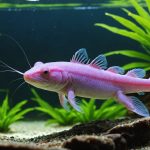Is a Standard Tropical Aquarium Ideal for Your Pet Axolotl?
When considering bringing an axolotl into your home, one of the first questions you might ask is whether a standard tropical aquarium is the right environment for these unique creatures. Axolotls, with their adorable faces and intriguing characteristics, have captured the hearts of many aquarium enthusiasts. However, their specific needs differ significantly from those of typical tropical fish.
Understanding Axolotl Needs
Before diving into the specifics of aquarium setup, it's crucial to understand what axolotls require to thrive.
Lire également : Mastering Wildlife Encounters: Training Your Cockapoo for Safe Interactions in UK Parks
Water Conditions
Axolotls are native to the freshwater lakes and canals of Mexico, particularly Lake Xochimilco. They thrive in still or slow-moving water, which is a stark contrast to the fast-flowing environments often associated with tropical fish tanks. A standard tropical aquarium, designed for fish that prefer strong water circulation, may not be ideal for axolotls without some adjustments.
Temperature and pH
Axolotls prefer cooler temperatures, typically ranging from 15°C to 18°C (59°F to 64°F), which is lower than the temperatures usually maintained in tropical fish tanks. They also require a slightly acidic to neutral pH, between 7.4 and 8.5. These conditions are easier to maintain in a dedicated axolotl tank rather than a mixed tropical aquarium.
A lire en complément : How to Effectively Deter Badgers from Wreaking Havoc in Your Garden?
Space and Tank Size
Axolotls can grow quite large, up to 30 cm (12 inches) in length, so they need ample space to move around. A minimum tank size of 20 gallons is recommended for the first axolotl, with additional space for any further additions. This is larger than many standard tropical fish tanks, which often start at 10-15 gallons.
Comparing Tropical and Axolotl Aquariums
Here’s a detailed comparison between a standard tropical aquarium and an axolotl-specific tank:
| Characteristics | Standard Tropical Aquarium | Axolotl-Specific Tank |
|---|---|---|
| Water Flow | Strong circulation | Still or slow-moving water |
| Temperature | 22°C to 28°C (72°F to 82°F) | 15°C to 18°C (59°F to 64°F) |
| pH | 6.5 to 8.5 | 7.4 to 8.5 |
| Tank Size | Often 10-20 gallons | Minimum 20 gallons |
| Inhabitants | Various tropical fish | Axolotls, possibly newts |
| Filter System | Powerful filters for circulation | Gentle filters or no filter |
| Decorations | Plants, rocks, driftwood | Rocks, plants, minimal decor |
| Feeding | Varied diets for different fish | High-protein diet for axolotls |
Setting Up an Axolotl Tank
If you decide to create a dedicated axolotl tank, here are some key considerations:
Choosing the Right Filter
Axolotls do not require strong water circulation, so a gentle filter or even no filter at all can be suitable. However, some filtration is necessary to maintain good water quality. A sponge filter or a low-flow hang-on-back filter would be more appropriate than the powerful filters used in tropical fish tanks.
Selecting the Right Food
Axolotls are carnivorous and require a high-protein diet. Foods like the Zoo Med Axolotl & Aquatic Newt Food, which are specifically formulated for axolotls and newts, are ideal. Avoid feeding them fish food, as it lacks the necessary nutrients for their optimal health.
Maintaining Water Quality
Regular water changes are crucial to keep the water clean and healthy for your axolotls. Aim for a 10-20% water change every week. Also, ensure that the tank is free from copper and zinc, as these metals can be toxic to axolotls.
Practical Tips and Considerations
Here are some practical tips to help you create an ideal environment for your axolotl:
- Avoid Overcrowding: Give each axolotl ample space. Overcrowding can lead to stress and health issues.
- Monitor Water Parameters: Regularly check the temperature, pH, and ammonia levels to ensure they are within the safe range for axolotls.
- Provide Hiding Places: Include rocks, plants, and other decorations to provide hiding places and reduce stress.
- Avoid Mixing with Fish: Axolotls are not compatible with most tropical fish due to their different environmental requirements and the risk of predation.
Real-Life Examples and Anecdotes
Many axolotl owners have learned the hard way that standard tropical aquariums are not ideal for these creatures. Here’s an example:
"A friend of mine once tried to keep an axolotl in a tropical fish tank with strong water circulation. The axolotl was constantly stressed and eventually developed health issues. After switching to a dedicated axolotl tank with still water and the right temperature, the axolotl thrived," says Sarah, an experienced axolotl owner.
While it might be tempting to house your axolotl in a standard tropical aquarium, it is clear that their specific needs are better met in a dedicated environment. By understanding and catering to their unique requirements, you can ensure your axolotl lives a happy and healthy life.
In summary, if you're considering bringing an axolotl into your home, it's worth the investment to set up a tank that is tailored to their needs. Here are some final key points to remember:
- Dedicated Tank: Use a tank that is at least 20 gallons in size.
- Gentle Filtration: Opt for a sponge filter or low-flow hang-on-back filter.
- Cooler Temperatures: Maintain temperatures between 15°C to 18°C (59°F to 64°F).
- High-Protein Diet: Feed them foods specifically formulated for axolotls.
- Regular Maintenance: Perform regular water changes and monitor water parameters.
By following these guidelines, you can create an environment where your axolotl will not just survive but thrive.











